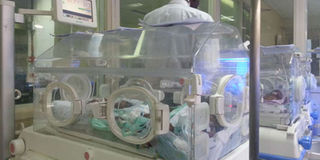Study: Low, advanced maternal age may lead to preterm births

The preterm unit at Kenyatta National Hospital. Girls giving birth below the age of 16 or women who do so after the age of 40 are at risk of getting low birthweight babies, the World Health Organisation has warned. PHOTO | BERNARDINE MUTANU | NATION MEDIA GROUP
What you need to know:
Women give birth after the age of 40 are at risk of getting low birthweight babies.
World Health Organisation has warned that the number of underweight babies are increasing.
The first estimates documentary by WHO has revealed that one in seven births worldwide are premature.
Girls giving birth below the age of 16 or women who do so after the age of 40 are at risk of getting low birthweight babies, the World Health Organisation has warned.
The global health agency has warned that the number of underweight babies are increasing.
The first estimates documentary by WHO has revealed that one in seven births worldwide are premature.
20 MILLION
The data also estimated that more than 20 million babies were born with low birthweight (less than 2500g; 5.5 pounds) in 2015.
The researchers said that the premature birth in young teenagers was related to "biological immaturity".
"It is also possible that the increased risk of poor pregnancy outcome in the teenage pregnancy is related to factors such as greater social deprivation and less prenatal care,” said the study.
The team said teenagers needed to be given proper medical checks during pregnancy.
PREGNANT
Some 378,397 adolescent girls in Kenya aged between 10 and 19 years became pregnant between July 2016 and June last year.
According to the United Nations Population Fund (UNFPA), 28,932 girls aged between 10 and 14 years got pregnant.
Counties with the highest burden of teenage pregnancies include Narok, in which 40 per cent of its teenagers became pregnant. It is followed by Homa Bay at 33 per cent, West Pokot 29 per cent, Tana River 28 per cent, Nyamira 28 per cent, Samburu 26 per cent, while Migori and Kwale both stand at 24 per cent.
Counties presenting the lowest burden include Murang'a, where only six per cent of teenagers became pregnant during the period. Nyeri was at seven per cent, and Embu at eight per cent.
MATERNAL HEALTH
Low birthweight (LBW), according to the WHO definition, is a birthweight below less than 2500g.
Being an important marker of maternal and foetal health, it is usually applied to live births only.
The study collected 1447 country-years of birthweight data (281 million births) for 148 countries of 195 UN member states (47 countries had no data meeting inclusion criteria).
The estimated worldwide LBW prevalence in 2015 was 14·6 per cent compared with 17.5 per cent in 2000.
In 2015, an estimated 20.5 million live births were LBW, 91 per cent from low-and-middle income countries, mainly southern Asia 48 per cent and sub-Saharan Africa 24 per cent.
NUTRITION
“Although these estimates suggest some progress in reducing LBW between 2000 and 2015, achieving the 2·74 per cent required between 2012 and 2025 to meet the global nutrition target will require more than doubling progress, involving both improved measurement and programme investments to address the causes of LBW throughout the lifecycle,”
“Giving birth to small babies is a substantial public health problem in every country, associated with a range of both short-term and long-term consequences affecting human capital. The children also have a higher risk of morbidity and stunting in childhood,” said the study.
The findings published in The Lancet Global Health states that more than 80 per cent of neonatal deaths are in LBW newborns, of which two-thirds are preterm and one third are term small-for-gestational-age.
PRE-TERM BABIES
“Low birthweight is a complex clinical entity composed of intrauterine growth restriction and pre-term birth,” says co-author Dr Mercedes de Onis from the Department of Nutrition at WHO.
“Reducing low birthweight requires an understanding of the underlying causes in a given country. For example, in Southern Asia, a large proportion of low birthweight babies are born at term but with intrauterine growth restriction, which is associated with maternal undernutrition, including maternal stunting.
These findings are documented in a new research paper developed by experts from the World Health Organisation, Unicef and the London School of Hygiene & Tropical Medicine.
INFECTION
“Preterm birth is the major contributor to low birthweight in settings with many adolescent pregnancies, high prevalence of infection, or where pregnancy is associated with high levels of fertility treatment and caesarean sections). Understanding and tackling these underlying causes in high-burden countries should be a priority,” Dr de Onis said.
Although close to three-quarters were born in Southern Asia and sub-Saharan Africa, the problem remains substantial in high-income countries in Europe, North America, Australia and New Zealand. There has been no progress in high-income countries.
MATERNAL CARE
The study suggests that reducing the incidence of low birth weight requires a comprehensive global strategy, which must include improving maternal nutritional status; treating pregnancy-associated conditions such as pre-eclampsia (hypertensive disease of pregnancy); and providing adequate maternal care, perinatal clinical services and social support.
Affordable, accessible and appropriate health-care is critical for preventing and treating low birthweight.
Reductions in death, illness and disability in newborn babies will only be achieved if pregnancy care is fully integrated with appropriate care for low birthweight babies.





